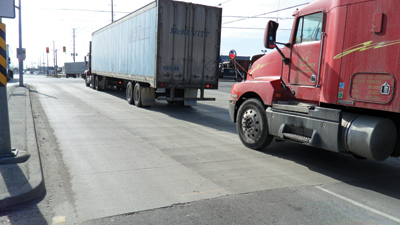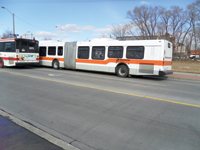
Concrete overlays, formerly known as whitetopping, inlays and
ultra-thin whitetopping, are just what the name suggests – laying
concrete over asphalt, composite or old concrete pavements for
environmentally friendly, long-lasting and cost-effective
rehabilitation.
Concrete overlays, formerly known as whitetopping, inlays and ultra-thin whitetopping, are just what the name suggests – laying concrete over asphalt, composite or old concrete pavements for environmentally friendly, long-lasting and cost-effective rehabilitation. Concrete overlays can rejuvenate busy intersections and asphalt roads rutted by heavy truck and bus traffic with a new, rigid surface. Depending on the application, traffic requirements and condition of the asphalt structure, an overlay may be as thin as 50 mm or as thick as 200 mm or more.

|
| Bonded concrete overlay in March 2010, after 14½ years of service.
|
Concrete overlays may be either bonded or unbonded. In general, bonded overlays are normally used for resurfacing and minor rehabilitation, while unbonded overlays are used to rehabilitate pavement that shows some structural deterioration.
Bonded overlays provide added structural capacity and eliminate surface distress, such as rutting and shoving. A bonded overlay becomes an integral part of the pavement structure, so the existing pavement must be in good condition, with no significant stresses. If rutting is 50 mm or more, the asphalt surface is milled to correct the profile and improve the bond between the concrete overlay and asphalt. A minimum of 75 to 100 mm of structurally sound asphalt must remain after milling to ensure proper performance of the bonded overlay. The bond between the two pavements is critical. It ensures the concrete overlay and existing asphalt pavement perform as one structure, with the asphalt continuing to carry a significant portion of the load. Bonded overlays are generally thin – from 50 mm to 125 mm.
Unbonded overlays are new pavements constructed atop existing pavement that act as a stable base of known performance. In this case, a bond between the pavements is not required to achieve the desired performance. These pavements are normally thicker than bonded overlays, usually in the range of 100 mm to 275 mm. Pre-overlay repairs are generally not required, unless there are significant distress areas that are shifting and moving or the subgrade/subbase is not stable. Milling of the existing asphalt surface may be required if the surface distortions, such as rutting or shoving, are 50 mm or more. If required, a layer of asphalt can be placed between the existing and new pavement to prevent any stresses in the old pavement from affecting the performance of the new one.
For thick overlays, it may be necessary to mill down the original road surface 100 to 150 m approaching and exiting an overpass to ensure proper clearance for truck traffic.
Concrete overlays have been successfully used in Canada and United States for several decades on roadways and intersections. The procedure has extended pavement life for as long as 30 years. Overlays can also be used at airports, where runways, taxiways and aprons must bear the weight of increasingly heavy airplanes on a very smooth surface.
 |
|
| Unbonded concrete overlay after 6½ years of service.
|
Bonded concrete overlays were first used in Canada in 1995 to rehabilitate an intersection at Britannia and Dixie Roads in Mississauga, which was subject to extensive rutting from heavy truck traffic. The damaged asphalt was milled out and replaced with an average of 140 mm of bonded concrete overlay. The thickness of the remaining asphalt after milling varied from 51 mm to 235 mm. Joints were saw-cut in 1.6 m square panels. A visual inspection in 2010 revealed that the 14 ½-year-old concrete overlay was in very good condition, with minimal cracks and spalling.
Another example of the proven performance of bonded concrete overlays is the resurfacing of two turning lanes at a highway intersection in Lethbridge, Alta., in 2004. This intersection also carried heavy truck traffic and suffered from severe rutting. Conventional asphalt repairs were lasting for only a year or two. Alberta Transportation sought a durable, long-term solution and chose a bonded concrete overlay. The concrete was placed over the original asphalt, milled down to an average depth of 125 mm. Joints were saw-cut into the concrete pavement at 1.5 m intervals. The concrete overlay repair took only two days to complete. After more than five years of service, the overlay is performing very well, with no maintenance required to date.
An unbonded concrete overlay was constructed in the summer of 2003 at a heavily used “T” intersection on Bloor Street and Aukland Road in the city of Toronto. Bloor Street is a four-lane east-west arterial road carrying about 30,000 vehicles a day in 2003, with extremely heavy peak hour traffic. It is also a major bus route to the nearby Kipling subway station through Aukland road. Along Bloor Street, the original structure was a composite pavement; Aukland Road had full-depth asphalt pavement. Both pavements were severely rutted and ravelled, with reflective and alligator cracks. On Bloor Street, the asphalt concrete surface was completely removed by milling to the underlying concrete base. The concrete base was then tack-coated before placing a 25 mm asphalt debonding layer, followed by 150 mm of 32 MPa concrete. Contraction joints were cut in a grid pattern at a maximum spacing of 1.5 m and to ¼ of pavement depth. Dowel bars were used only in the curb lane areas where buses stop before turning. On Aukland Road, the original asphalt was replaced with 225 mm of concrete pavement for a distance of 63 m back from the intersection. Dowelled contraction joints were cut at a spacing of 4.5 m.
Visual inspection in the winter of 2010 showed that the entire pavement structure is still in excellent condition after 6 1⁄2 years service, with some cracks only in the catchbasin areas.
The Yellowhead Trail, a six-lane divided highway with access to major arterials through signalized intersections and interchanges in Edmonton, Alta., has a section of unbonded concrete overlay. As a major truck route running east-west through the northern half of the city of Edmonton, it carries approximately 8,000 heavy trucks a day. Two sections of the roadway between 124 and 127 streets, west of the municipal airport, required asphalt overlays every two years due to severe rutting. To overcome this problem, two Portland cement concrete pavement (PCCP) inlays were installed in 1994; a 200 m, three-lane section west of 127 Street in the eastbound lanes and a 300 m, three-lane section east of 127 Street in the westbound lanes.
The length of each treated section was dictated by the amount of rutting present. The existing asphalt pavement was 300 mm thick, on a 150 mm layer of soil cement. A 225 mm unbonded concrete overlay was placed on the damaged areas after milling out the existing asphalt and leaving 75 mm as support for the new PCCP. After more than 15 years of service, the concrete inlays are in very good condition and have had only minor maintenance – some joint sealant replacement.
Benefits of concrete overlays
Concrete overlays can rehabilitate all types of pavement in a variety of conditions to achieve the desired service life. Their economic benefits include stable concrete prices compared to fluctuating, oil-linked asphalt prices and minimal pre-overlay work as existing pavement serves as a base and need not be removed. In addition, the overlay thickness can be varied as needed and there is a single-pass placement of concrete. Overlays provide fast-track construction with the new pavement open to traffic within a day of placement, require fewer lifetime maintenance and rehabilitation interventions and stand up to seasonal stresses while their reflective surface reduces lighting costs.
The sustainability and environmental advantages of overlays include reduced fuel consumption for vehicles, reduced emissions from heavy trucks, reduced waste by the use of industrial byproducts in concrete mix, as well as less energy used to for their construction and maintenance. Overlays also reduce urban heat island effect, while the recyclable material can be removed economically and reused as high-quality, drainable base material for new pavement. In addition, their safety advantages include minimized pothole potential, less potential for hydroplaning, good skid resistance and improved night visibility.
This article was submitted by the Cement Association of Canada.
Print this page